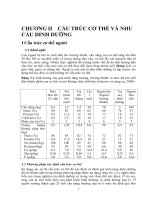NHU cầu DINH DƯỠNG (NHI KHOA)
Bạn đang xem bản rút gọn của tài liệu. Xem và tải ngay bản đầy đủ của tài liệu tại đây (914.98 KB, 12 trang )
1. Giải thích được tại sao nhu cầu dinh dưỡng
của trẻ em lại cao hơn người lớn.
2. Tính được nhu cầu năng lượng và nước
theo tuổi và cân nặng.
3. Nêu được vai trò, nguồn cung cấp, nhu
cầu hàng ngày của các chất đạm, béo,
đường.
4. Nêu được nhu cầu hàng ngày của một số
chất khoáng và vitamine.
Basal metabolic rate (BMR): Rate of
energy expenditure after an
overnight fast, resting comfortably,
supine, awake, and motionless in a
thermoneutral environment.
Basal energy expenditure (BEE): BMR
over 24 hours.
Thermic effect of food (TEF): Increase in
energy expenditure elicited by food
consumption.
Energy deposition: Energy requirement for
growth.
Total energy expenditure (TEE): Sum of BEE,
TEF, physical activity, thermoregulation,
and the energy expended in depositing new
tissues and/or in producing milk.
Physical activity level (PAL): Ratio of
total to basal daily energy expenditure
(TEE/BEE). Describes and accounts for
physical activity habits.
Physical activity coefficient (PA): The
physical activity coefficient that
correlates with PAL can be used to
calculate estimated energy
requirements (EER).
EER: Dietary energy intake that is
predicted to maintain energy balance in
a healthy individual. In children, it
includes the needs associated with
growth. For most healthy infants and
children, the equations here can be
used to determine energy needs.
For infants, children, and adolescents,
EER (kcal/day) = TEE + energy
deposition.
For most hospitalized patients, it can
be assumed PAL = sedentary, PA = 1.
Phụ thuộc vào: tuổi, giới, CN, nhiệt độ
môi trường mức hoạt động thể lực.
Số năng lượng cần của khẩu phần ăn
phải cung cấp đầy đủ tất cả các tiêu hao
của cơ thể gồm: Chuyển hóa cơ thể,
tăng trưởng, hoạt động thể lực.
Đơn vị đo lường kcal.
3 chất cung cấp năng lượng chủ yếu:
1
g Protéin cho 4 kcal
+
1 g Glucid cho 4 kcal
+
1g lipid cho 9 kcal
G:P:L
= 60% - 13% - 27%
Theo công thức Holliday-Segar:
10 kg
>10
:
–20 kg :
100 kcal /kg
1000kcal + 50
kcal /kg
>
20 kg
:
1500 kcal + 20 kcal /kg









